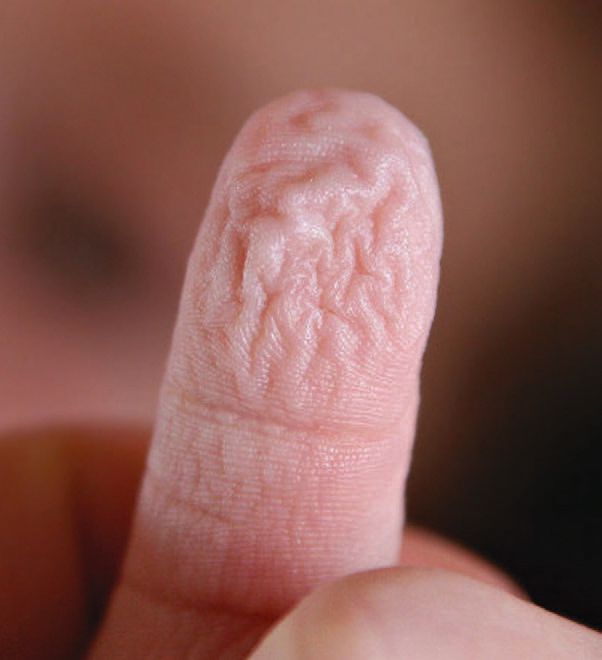Tribology in the bathtub
Evan Zabawski | TLT From the Editor May 2014
Researchers attempt to solve an age-old mystery.

Is there a purpose in our skin reacting in this manner?
www.canstockphoto.com
WHY DO OUR FINGERS AND TOES GET WRINKLY AFTER SOAKING IN THE TUB? Common perception is that the wrinkles are a local effect on the skin due to swelling caused by osmosis, but recent evidence has shown that there is actually a reduction in volume caused by vasoconstriction (narrowing of blood vessels by small muscles in their walls).
The next question is how does vasoconstriction occur? In the early 1930s, cardiologists Sir Thomas Lewis and Sir George Pickering were studying vasodilation (expanding of blood vessels), and one of their cases involved a boy with a severed nerve in his arm causing numbness in three of his fingers. When immersed in water, the boy’s two fingers with feeling wrinkled but the other three would not, and the wrinkles on his palm were “almost sharply separated by a line” from his fingers to his wrist. This offered proof the effect was not entirely local and somehow related to the nervous system.
Neurologist Einar Wilder-Smith’s recent research suggests that finger wrinkling relies on nerve endings that entangle sweat glands and blood vessels in our fingers. Some nerves either tell blood vessels to constrict or allow them to relax depending on signals like temperature. Finger wrinkling can occur in both hot and cold water, so the explanation is not that simple.
Sweat glands not only allow sweat out, they also allow water in. When that water comes in contact with nerve fibers, they begin firing to tell the arterioles (small blood vessels) to constrict. Arterioles constricting as a group create a void between the skin and blood vessels causing the skin to sink inward, which creates the wrinkles.
Now the question is why should this occur? Is there a purpose in our skin reacting in this manner? A hypothesis put forward by evolutionary neurobiologist Mark Changizi suggests the wrinkles behave like rain treads on tires to create better grip. This is consistent with the fact that the wrinkling occurs on the areas of skin in contact with surfaces and objects to be manipulated. Kyriacos Kareklas, Daniel Nettle and Tom V. Smulders were prompted to create an experiment to measure the effect of water wrinkles in order to prove this hypothesis.
Their experiment involved manipulating submerged and dry objects, both with wrinkled and unwrinkled fingers. The order in which dry and submerged objects were handled was counter balanced across participants, as was the order in which wrinkled versus unwrinkled hands were tested. The findings were published in a paper titled “Water-induced finger wrinkles improve handling of wet objects” in
Biology Letters and showed a clear advantage in handling submerged objects with wrinkled fingers but no difference in handling dry objects.
While the results clearly proved the advantage, they did not address how this is accomplished. It could be that the wrinkles did act like rain tread and helped with the evacuation of water between the skin and the object. Another possibility is that the skin undergoes an increase in adhesion or in its coefficient of friction. The paper ends by questioning why fingers aren’t wrinkled all the time. The posit is that there must be some cost to wrinkled fingers that outweighs its benefits under dry conditions.
Let’s hope further research sheds light on the actual mechanism behind the better grip so that we may understand the true purpose of water wrinkles. This temporary environmental adaption must have a purpose, and perhaps it will be a tribologist who discovers exactly how it functions.
 Evan Zabawski, CLS, is the senior reliability specialist for Fluid Life in Edmonton, Alberta, Canada. You can reach him at evan.zabawski@fluidlife.com
Evan Zabawski, CLS, is the senior reliability specialist for Fluid Life in Edmonton, Alberta, Canada. You can reach him at evan.zabawski@fluidlife.com.